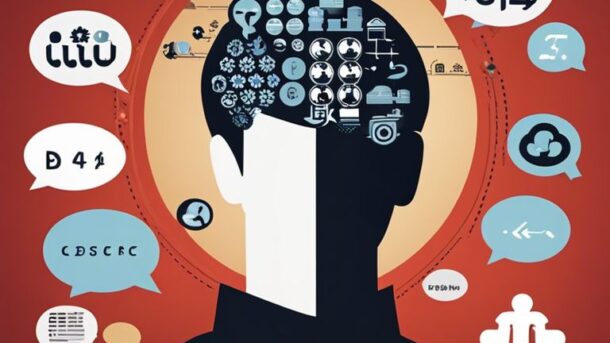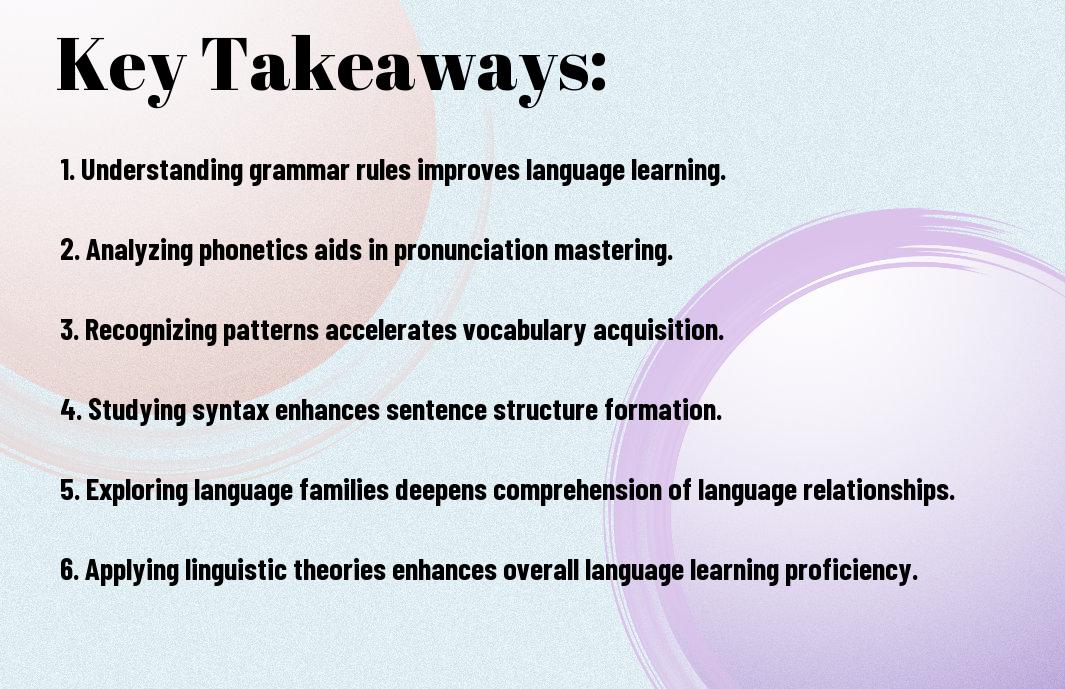As you navigate the complexities of human communication, you may wonder how the language you speak influences your thought processes. Your native tongue shapes the way you perceive and understand the world, affecting your cognitive abilities and behavior. You will discover that the language you use can impact your problem-solving skills, memory, and even your emotional responses, revealing a profound connection between language and thought.
Key Takeaways:
- The language we speak can influence our thought processes and perception of the world, shaping the way we think and behave.
- Cognitive abilities, such as problem-solving and memory, can be impacted by the linguistic structures and vocabulary of our native language.
- The grammar and syntax of a language can affect how we organize and process information, with some languages being more efficient than others in certain contexts.
- The connection between language and thought is a two-way street, with our culture and environment also influencing the way we think and communicate.
- Neuroplasticity allows our brain to adapt and change in response to new language learning, demonstrating the dynamic relationship between language and thought processes.

Language and Cognition
The connection between language and thought processes is a complex one, and you will find that your understanding of this relationship can deepen your insight into your own cognitive abilities. As you explore this topic, you will discover how language influences your perception of the world and shapes your thoughts.
The Relationship Between Language and Thought
For instance, when you learn a new language, you are not only acquiring new words and grammar rules, but also new ways of thinking and conceptualizing ideas. Your brain is adapting to a new system of communication, and this can affect your problem-solving skills and decision-making processes.
Linguistic Relativity Hypothesis
Thought provoking studies have led to the development of the linguistic relativity hypothesis, which suggests that the language you speak influences your thought patterns and perception of reality. You may find that your native language shapes your worldview and influences the way you categorize objects, events, and ideas.
Relationship between language and thought is further explored in the linguistic relativity hypothesis, where you will find that the grammar and vocabulary of your language can influence your spatial reasoning, color perception, and even your sense of time. As you examine deeper into this topic, you will discover how your language can shape your cognitive biases and influence your behavior, making you more aware of the complex dynamics between language and thought.

Thought Processes and Language Acquisition
Some researchers suggest that the language you speak influences your thought processes, shaping the way you perceive and understand the world. As you acquire a new language, you are not only learning new words and grammar rules, but also adopting a new way of thinking.
How Language Influences Perception
Processes such as categorization and memory are affected by the language you speak, influencing how you perceive and interpret sensory information. You will find that your language shapes your ability to distinguish between similar objects or colors, for example.
The Role of Language in Shaping Reality
Below the surface of everyday communication, language plays a significant role in constructing your reality. You will discover that the words and concepts you use to describe the world around you influence your thoughts and perceptions, creating a unique understanding of reality.
Language has the power to shape your reality by influencing your thoughts, perceptions, and behaviors. As you learn to speak and think in a new language, you will begin to see the world from a different perspective, noticing nuances and distinctions that were previously unknown to you. You will find that your language shapes your identity and informs your understanding of the world, making you a more empathetic and open-minded person.
Cognitive Biases and Language
All languages influence your thought processes, and this connection is evident in cognitive biases. Your native language shapes your perceptions, judgments, and decisions, often unconsciously. As you navigate different linguistic environments, you may notice variations in your thought patterns.
How Language Affects Decision Making
Around the time you start learning a new language, you begin to realize how it impacts your decision-making processes. Your language’s grammatical structures and vocabulary can sway your choices, making you more inclined to certain options over others. You may find that your decision-making style changes depending on the language you are using.
The Impact of Language on Mental Frameworks
Beneath the surface of your conscious awareness, language plays a significant role in shaping your mental frameworks. Your native language influences your categorization of objects, events, and ideas, which in turn affects your problem-solving abilities and critical thinking. You will notice that your language’s nuances shape your understanding of the world.
Further exploration of the impact of language on mental frameworks reveals that you are not only influenced by the language you speak, but also by the cultural context in which you use it. As you become more aware of these influences, you can develop a deeper understanding of your own thought processes and become a more nuanced thinker, capable of navigating complex linguistic and cultural landscapes with greater ease. You will find that this awareness allows you to make more informed decisions and develop a more flexible mindset.
Cultural Variations in Language and Thought
After exploring the relationship between language and thought, you’ll find that cultural variations play a significant role in shaping your perception. You can learn more about Language and Thought to understand how different cultures influence your thought processes.
Language and Cultural Differences in Perception
The way you perceive the world is closely tied to the language you speak, and cultural differences can significantly impact your understanding of various concepts and ideas.
The Influence of Culture on Linguistic Expression
At the heart of linguistic expression lies the cultural context in which you communicate, and you’ll find that your culture shapes the way you express yourself.
Language is deeply rooted in culture, and as you explore the influence of culture on linguistic expression, you’ll discover that your cultural background plays a significant role in shaping your language use, from the words you choose to the tone and nuance you convey, ultimately affecting how you interact with others and navigate your social world.
Neuroscientific Perspectives
Your brain’s ability to process language is a complex phenomenon that has been studied extensively in the field of neuroscience, offering valuable insights into the connection between languages and thought processes.
Brain Structure and Language Processing
For instance, neuroimaging techniques have shown that language processing involves a network of brain regions, including Broca’s area and Wernicke’s area, which work together to facilitate language comprehension and production.
The Neuroscience of Language and Thought
Any investigation into the neuroscience of language and thought reveals a intricate relationship between the two, with language influencing your thought processes and vice versa, highlighting the dynamic interplay between language, culture, and cognition.
Understanding the neuroscience of language and thought can help you appreciate the ways in which your language shapes your perceptions, attention, and memory, and how, in turn, your thoughts and experiences influence your language use, creating a continuous feedback loop that refines and adapts your cognitive abilities.
Implications and Applications
Unlike other areas of study, the connection between languages and thought processes has significant implications for your understanding of human behavior and cognition. You will find that this connection has far-reaching consequences for various fields, including education, social sciences, and psychology.
Language Teaching and Learning
To effectively learn a new language, you should consider the relationship between language and thought processes. You will discover that your native language influences your perception and comprehension of new languages, making it imperative to adapt your teaching and learning approaches accordingly.
The Role of Language in Social Interactions
Among the various aspects of human communication, language plays a vital role in shaping your social interactions. You will notice that language affects how you perceive and interact with others, influencing your relationships and social dynamics.
Language has a profound impact on your social interactions, as it enables you to convey your thoughts, emotions, and intentions to others. As you engage in conversations, you will find that language helps you navigate complex social situations, build relationships, and establish your identity within a community, allowing you to effectively communicate and connect with others in a meaningful way.
Summing up
Now, as you consider the relationship between languages and thought processes, you’ll find that your native language influences your perception and cognition. You’ll notice that your language shapes your understanding of the world, and your thoughts are filtered through its unique structures and vocabulary. As you explore this connection, you’ll gain insight into how your language impacts your worldview and shapes your interactions with others.
FAQ
Q: How do languages influence thought processes and cognitive development in individuals?
A: The connection between languages and thought processes is complex and bidirectional. On one hand, language can shape thought by providing the categories and concepts that influence how we perceive and understand the world. For instance, languages that have specific words for certain colors can lead speakers to be more adept at distinguishing between those colors. On the other hand, our thought processes and the environment we grow up in can influence the language we speak. For example, languages spoken by people in areas with significant maritime activities may have a more detailed vocabulary related to the sea and navigation.
Q: Can the structure of a language limit or enhance an individual’s ability to think in certain ways or understand complex concepts?
A: Yes, the structure of a language can both limit and enhance an individual’s cognitive abilities. For instance, languages with precise grammatical structures for expressing tense and aspect can make it easier for speakers to understand and discuss complex temporal relationships. Conversely, languages without specific vocabulary for certain concepts may require speakers to use more circumlocutions or metaphors to convey their thoughts, potentially making some discussions more cumbersome. However, this does not necessarily limit a speaker’s ability to think about those concepts, as evidenced by the ability of people from diverse linguistic backgrounds to grasp and contribute to complex, universally relevant ideas in fields like science and philosophy.
Q: Does bilingualism or multilingualism have a significant impact on cognitive processes and the way individuals perceive and interact with their environment?
A: Bilingualism and multilingualism are known to have profound effects on cognitive processes. Individuals who speak multiple languages often exhibit enhanced executive control, which includes abilities such as planning, problem-solving, and multitasking. The constant switching between languages can also improve meta-linguistic awareness, allowing bilingual or multilingual individuals to have a better understanding of language structures and potentially making them more adept at learning new languages. Furthermore, being proficient in multiple languages can broaden one’s worldview by providing access to different cultural perspectives and literature, thereby enriching an individual’s perception and interaction with their environment in meaningful ways.



